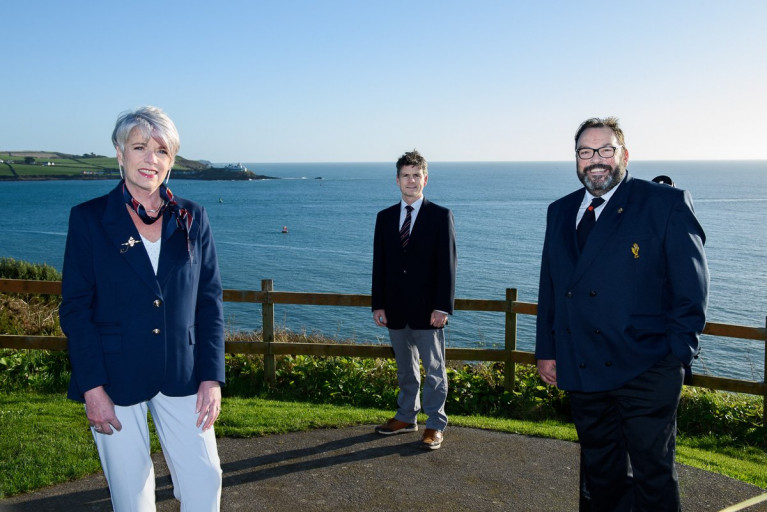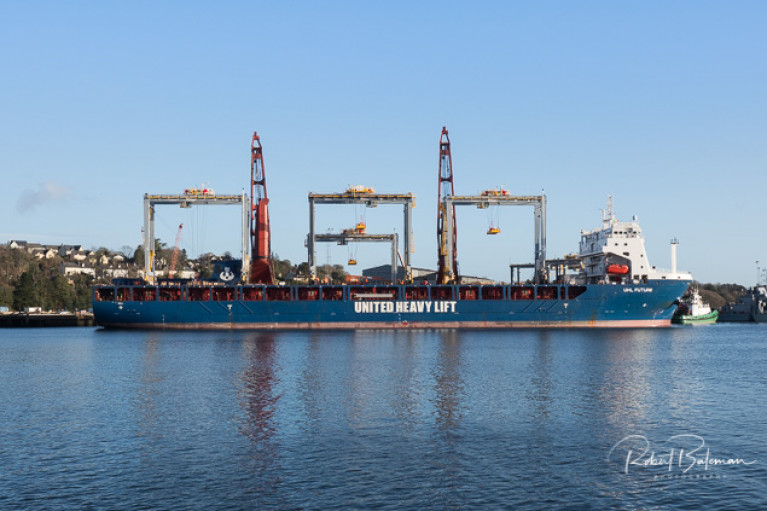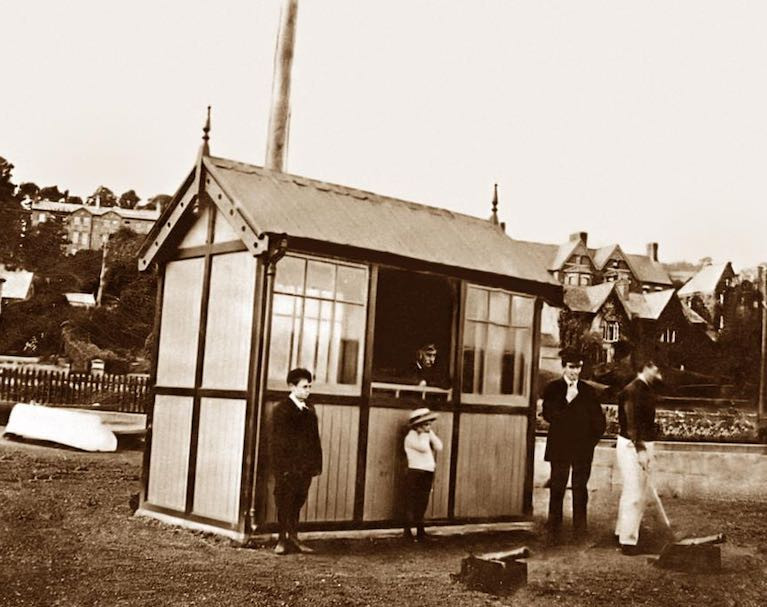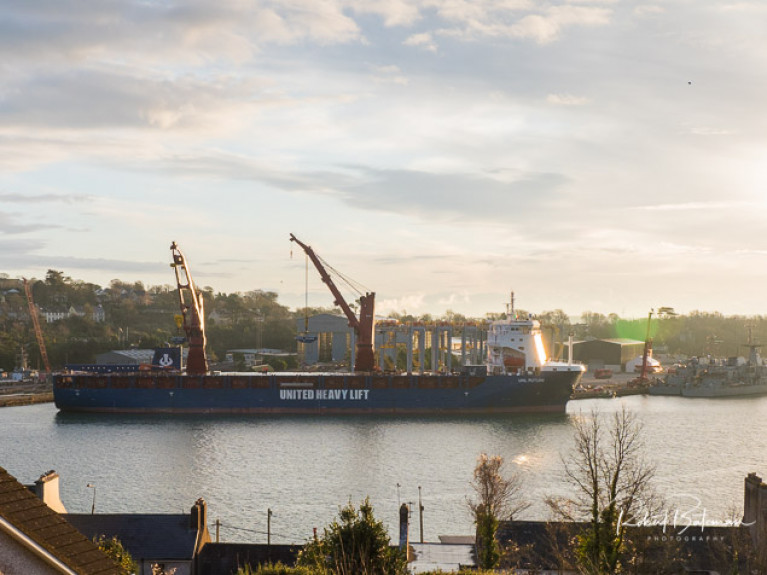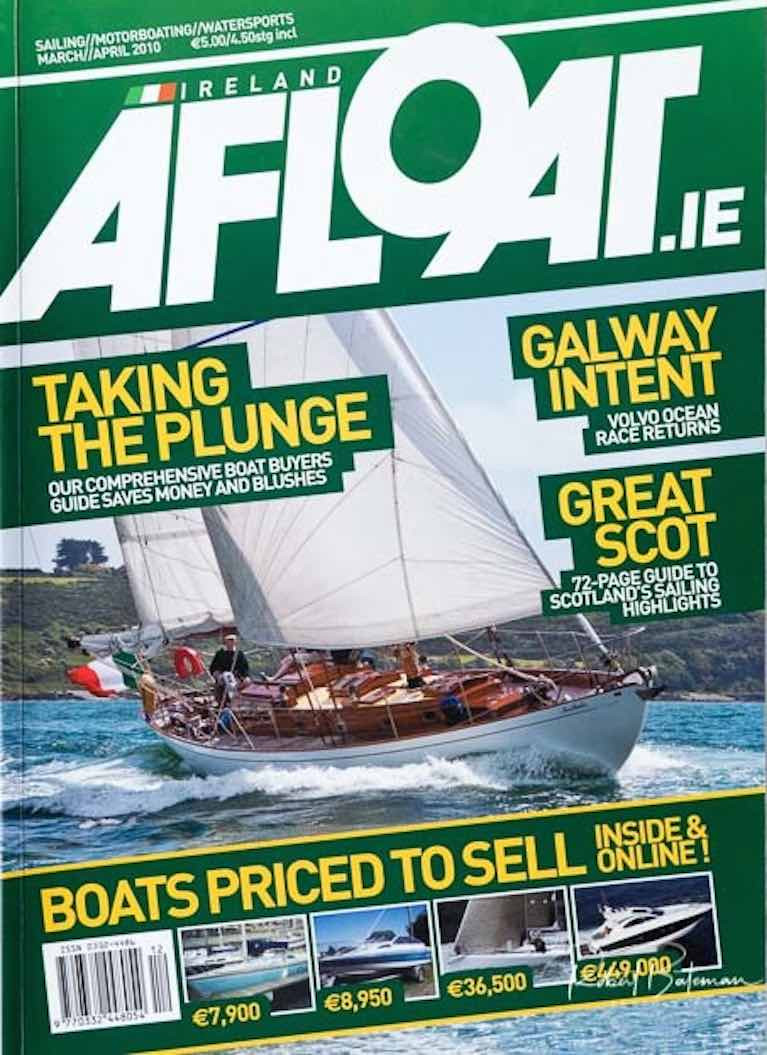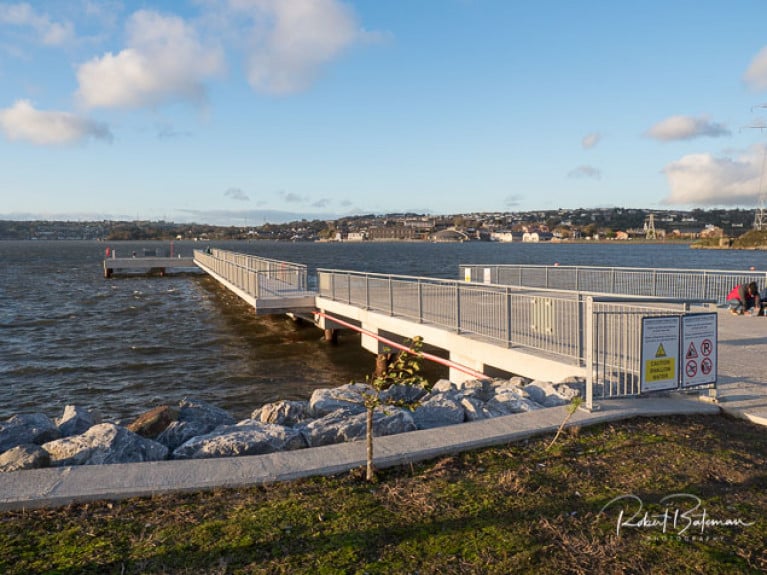Displaying items by tag: Cork Harbour
Annamarie Fegan and Ross Deasy will co-chair Cork Week 2022, Royal Cork Yacht Club has announced.
Deasy who has raced as part of many RCYC keelboat campaigns in the last 25 years, including a Commodore’s Cup win onboard Antix, will chair Cork Week's racing committee. Fegan who has been campaigning the family Grand Soleil ’40 both inshore and offshore in recent years, including a win in this year’s inaugural Fastnet 450 Race, will chair the shore-side events.
As Afloat previously reported, the date has been set for Cork Week 2022 from Monday, July 11th to Friday, July 15th 2022.
With Volvo Cork Week 2020 having been cancelled as a result of the global pandemic, RCYC is extending its Tricentenary celebrations with a number of significant events in the coming years, including Cork Week 2022.
The 300th anniversary of the oldest yacht club in the world is a momentous occasion and the Royal Cork welcomes members, guests and visitors to join them for world-class racing and shore-side entertainment.
Cork Week organisers have committed to publishing an advanced notice of race by Easter 2021, thus giving boat owners and captains plenty of time to make plans to attend this very special event in Cork which organisers hope will achieve the 300+ boats expected for Volvo Cork Week 2022.
Honorary life member and former Admiral of the Royal Cork, Anthony O’Leary, joins the committee as an advisor for 2022.
The committee will be supported by Alex Barry in communications, General Manager of the Royal Cork, Gavin Deane, and Rear Admiral of Keelboat racing in the Royal Cork, Daragh Connolly.
UHL Focus, the second of two heavy lift vessels has loaded four of eight RTG cranes in the Port of Cork for discharge in Berbera, Somaliland.
As Afloat reported earlier, the heavy-lift operations have been ongoing at Cork Dockyard in Cork Harbour this month when the first shipment was loaded on to UHL Future,
This week's second sister ship arrival will load the other half of the Liebherr cargo. The vessel, a General Cargo Ship was built in 2019 and is sailing under the flag of Madeira.
As regular readers will recall, the consignment for Somaliland arrived at the Cork Docks in October.
Cork Harbour's Green Rebel Marine Buys Aircraft for Aerial Surveys off the Irish Coast
Green Rebel Marine with a base at Crosshaven Boatyard in Cork Harbour has announced the €1.5 million purchase of a DA42 multi-purpose aircraft to conduct aerial surveys off the Irish coast.
Thousands of square miles of ocean are due to undergo ecological assessment as part of the planning process for offshore wind farms.
The new aircraft will be based at Cork Airport, and will result in the creation of fifteen new jobs. These jobs are in addition to the eighty announced by Green Rebel Marine in September.
With the purchase of its own survey aircraft, Green Rebel Marine will be the only domestic Irish company offering digital aerial surveys for offshore wind development companies.
The twin-engined DA42 MPP is rated as best in class in terms of fuel efficiency and emissions, and is equipped with high-performance aerial cameras to conduct ecological surveys.
Green Rebel Marine was established earlier this year to service the future needs of offshore wind farms. The company has already acquired Crosshaven Boatyard in County Cork, and the first in a fleet of survey vessels, the Bibby Athena.
Plans for offshore wind farms are at an advanced stage with a number of potential fixed and floating operators examining sites along the coast from Dundalk in County Louth, to the Cork coast and beyond. Their construction will not only increase Ireland’s ability to produce renewable energy, it will also create an entire new sector dedicated to servicing their operation.
Sarah Kandrot, Head of Aerial Surveys with Green Rebel Marine, says, “Off-shore energy is part of the green revolution, however the granting of licences for these wind farms is dependent on detailed surveys of the ocean to catalogue the ecology of the target areas. The purchase of this aircraft means that large sections can be digitally surveyed over a shorter period of time, with the aircraft flying at heights that will not disturb birds or marine megafauna. Ultimately, the information we compile will ensure that offshore wind farms are built in the best locations to protect the ecology of the ocean.”
Green Rebel Marine founder Pearse Flynn says, “The purchase of the survey aircraft, along with the first in our fleet of survey vessels, means that Green Rebel Marine is leading the charge towards sustainable and renewable energy off the Irish coast. This is an industry that will sustain thousands of jobs while transforming Ireland into a net generator of electricity. The oceans around Ireland are a vital resource, and the quality survey work being undertaken by Green Rebel Marine will help to both protect that resource while harnessing its potential.”
The Green Rebel Marine aircraft will be permanently based at Cork Airport once it enters full-time operation early next year.
Niall MacCarthy, Managing Director at Cork Airport, said: “2020 has been a tough year for everybody so it’s great to be starting 2021 with a good news story. Recovery and jobs will be THE theme for 2021 and an aircraft based with us in Cork which helps create new jobs particularly in the green energy sector is very welcome. The Green Rebel Marine Diamond Aviation 42 aircraft will be based at the Weston General Aviation Hangar at Cork Airport and we wish them every success in this exciting new offshore wind venture.”
Liebherr Cranes Loaded onto Heavy Lift Ship at Port of Cork
UHL Future, the first of two heavy lift vessels has loaded four of eight RTG cranes in the Port of Cork for discharge in Berbera, Somaliland.
As Afloat reported earlier, the heavy-lift operations have been ongoing at Cork Dockyard in Cork Harbour this week.
A second sister vessel will load the other half of the Liebherr cargo next week.
As regular readers will recall, the consignment for Somaliland arrived at the Cork Docks in October.
Monkstown Bay Sailing Club's Resurgence in Cork Harbour: Podcast with Commodore Sandy Rimmington
Despite the impact of the pandemic Monkstown Bay Sailing Club in Cork Harbour has had a resurgence of numbers in dinghy league racing.
So outgoing Commodore Ciaran McSweeney told club members as he completed his two-year term in office.
New investment has been made in club facilities and there is a lot of hope in the village club on the edge of the harbour for next year.
It has bought a 1720 sportsboat, been donated a Drascombe Lugger, has more volunteers than before, more adults are seeking training and it also has put a new racing on the Sand Quay in the centre of the village, from where races are run. That is a short distance from the clubhouse at De Vesci Place. The hut has thrown "an invaluable light" on sailing history in Monkstown according to the outgoing Commodore. It makes Monkstown part of the history of the Royal Cork Yacht Club.
 Monkstown Bay Sailing Club's new race hut
Monkstown Bay Sailing Club's new race hut
Completing his two-year term of office he told members that the club had received a collection of photos of the Sand Quay and the famous hut from member John Hegarty. One of these shows uniformed Race Officers during a starting sequence on the quay for a yacht race that is thought to predate 1922.
"According to historian Dr Alicia St.Leger, the original hut was put in place by the Royal Munster Yacht Club in 1905. It remained there after that club departed for Crosshaven in 1922."
The Royal Munster later amalgamated with the Royal Cork which club had been based in Cobh and moved to Crosshaven to join the Royal Munster under the name of the RCYC. According to MBSC the "hut" remained on the quay and survived well into the 1950s. It was moved around the quay area several times, but the remains of an original concrete base can be seen slightly to the north of the location of the present hut. There have been others, right up to the new one.
Sandy Rimmington has been elected the new MBSC Commodore. Jacqui O'Brien is Vice Commodore.
Now listen to the Podcast below where my guest this week is the new MBSC Commodore.
Heavy lift operations are planned at Cork Dockyard in Cork Harbour today loading project cargo (Afloat understands to be Liebherr gantry cranes) onto the vessel ‘UHL Future’.
Operations will occur at multiple times per day, for periods of up to 2-3 hrs per lift & planned to be completed within five days.
UHL Future is part of the German Unique Heavy Lift fleet based in Hamburg. The ship is almost brand new, built in 2019 and sailing under the flag of Portugal.
It’s carrying capacity is 14058 t DWT and her current draught is reported to be 6.7 metres. Her length overall (LOA) is 149.97 meters and her width is 25.9 metres.
See UHL Future slideshow below by Bob Bateman
Royal Cork Yacht Club to Host 2021 Topper Worlds in Cork Harbour
The 2021 International Topper World Championships will be hosted by the Royal Cork Yacht Club, Ireland, from the 24th to 30th July.
As Afloat reported previously, the event will attract up to 200 young sailors from around the world and it has been planned to dovetail with the UK National Championships, following on two days later at Ballyholme YC in Northern Ireland, from the 2nd to 6th August – providing sailors with a fun, fortnight festival of top-quality racing.
The club and ITCA are currently finalising plans for the event and will, of course, be closely monitoring the situation regarding COVID-19.
Entry will open January 1st 2021.
Cork Harbour Sailing venue
Cork Harbour is a natural harbour, with stunning scenery and provides a perfect location for any sailing championship. Claimed to be the second biggest in the world after Sydney Harbour, it has room for two protected races areas within the harbour and a further three out in the bay.
Crosshaven Regeneration of Classic Yacht Northele is a Special Mission for Family, Friends & Shipmates
When Anthony and Sally O'Leary of Crosshaven quietly decided that some day they were going to make the classic 50ft 1949-vintage sloop Northele a member of their extended sailing family, it was a sort of Breakfast Epiphany. The boat had been hidden in plain sight for a while, moored in the anchorage up towards Drake's Pool, and so easily visible from their breakfast table that they tended to see her as part of the scenery. That is, until one day Northele (it's pronounced almost like "northerly") was lying with such grace in the morning sunlight that Himself was transfixed in mid-cereal, and suddenly announced: "Someday, we're going to own that boat". And Herself agreed.
But when you're Anthony and Sally O'Leary of Crosshaven, it means you're at the heart of a multi-generational family story combining the O'Leary and Aisher owner-skippering of many successful cutting-edge new boats from front-rank designers of the calibre of Charles Nicholson, Olin Stephens, Dick Carter, Ron Holland, Doug Peterson, Tony Castro, John Corby and Jason Ker.
 In at the sharp end – Anthony O'Leary helming his Ker 39 Antix flat out in the RORC Easter Regatta in the Solent. Photo: Courtesy RORC
In at the sharp end – Anthony O'Leary helming his Ker 39 Antix flat out in the RORC Easter Regatta in the Solent. Photo: Courtesy RORC
 A very different kind of sailing. Anthony and Sally O'Leary and friends enjoying Northele's stately progress. Photo: Robert Bateman
A very different kind of sailing. Anthony and Sally O'Leary and friends enjoying Northele's stately progress. Photo: Robert Bateman
 Northele as she used to be in the old days, part of the scenery from Anthony & Sally O’Leary’s garden. Photo: Richard Gibson
Northele as she used to be in the old days, part of the scenery from Anthony & Sally O’Leary’s garden. Photo: Richard Gibson
All of which makes it quite a step to change your sailing focus to a sweet-lined yet hefty craft more than seventy years old, designed by someone who is unknown to most sailing people. For although Northele is indeed a yacht of undoubted classic elegance, she was created by A.K. "Sandy" Balfour whose name – while immediately recognised by true connoisseurs – does not have the immediate populist cachet of Herreshoff, Fife, Mylne, Nicholson, Stephens, Rhodes or Reimers when classic yachts gather in all their gleaming glory.
But for anyone with an eye for a boat, even the briefest glimpse of Northele reveals such seemingly effortless style that you would readily accept that she was conceived by any of those very distinguished designers at the top of their form. But in addition to that, she has a certain special something which raises her above small-minded considerations of value-adding provenance.
 "The surgeons will see you now". Having been stripped of paint and much else, Northele disappears into one of the Castlepoint Boatyard sheds at Crosshaven. Photo: Richard Gibson
"The surgeons will see you now". Having been stripped of paint and much else, Northele disappears into one of the Castlepoint Boatyard sheds at Crosshaven. Photo: Richard Gibson
 The job is on. Billy, Don and Alan Curran of Castlepoint Boatyard with Northele safely into the shed. Photo: Richard Gibson
The job is on. Billy, Don and Alan Curran of Castlepoint Boatyard with Northele safely into the shed. Photo: Richard Gibson
However, it was a busy time of maybe ten years before Northele finally joined the O'Leary-Aisher fleet continuum. During it, Anthony and Sally's sons amassed international racing trophies, while Anthony himself captained two winning Irish Commodore's Cup Teams and many other national and international championships, rounding it out with his hyper-hot Antix being the RORC Yacht of the Year. Yet through all those hectic years, they kept tabs on Northele, and in 2018, the time was right, and they bought her knowing that while she looked lovelier than ever, there was more than a little TLC required.
 Northele's hull profile and accommodation as they appeared in a Yachting World special Design Supplement in March 1950. Note how the propeller emerges from immediately above the rudder, and also how galley is located forward.
Northele's hull profile and accommodation as they appeared in a Yachting World special Design Supplement in March 1950. Note how the propeller emerges from immediately above the rudder, and also how galley is located forward.
In her seventy years, Northele had been around the block, and then some, for after the first owner Ronald Burton sold her, among other experiences she was in Plymouth and did a Round Britain and Ireland Race, she also found her way to the Caribbean, and then was based in the Clyde when a first Irish owner in Meath brought her to Ireland and based her in Kinsale, following which she was in Cork ownership and moored serenely at Crosshaven, waiting for Anthony and Sally O'Leary to take notice and be smitten.
We'll get all this intertwined history into its proper order in due course. Meantime, just who was Sandy Balfour? Born in Glasgow in the 1920s, after a boat-building apprenticeship with Harland & Wolff's Scottish subsidiary which included war work, his latent design talent was able to manifest itself by working with designer David Boyd at Roberston's Yard at Sandbank on the Clyde. Boyd may later have been associated with the unsuccessful America's Cup 12 Metre Sceptre, but when Balfour was with him, his boats for the International 6 Metre Class were very highly regarded, and of Olympic standard.
Yet by that time the mighty Scottish yacht design and building industry – at its height around the turn of the Century – was in marked decline, and in 1947 Balfour headed south to take up the job as manager and in-house yacht designer at Berthon Boat Company in Lymington in Hampshire. The yacht design profession – particularly in the depressed post-World War II era - was a precarious career for a sole trader, so a permanent job as yard manager, in tandem with whatever design challenges came along, provided a reasonably secure position.
 Berthon Boat Company provided a very businesslike and complete service in 1949 – the final bill for Northele not only included the sails, but at £5,848-0-0 cost was significantly less than the original quote of £6861
Berthon Boat Company provided a very businesslike and complete service in 1949 – the final bill for Northele not only included the sails, but at £5,848-0-0 cost was significantly less than the original quote of £6861
But the Berthon Boat Company were noted for their possessiveness towards any yacht designs which their employees created, and when the new 50ft Northele was launched in 1949, her design was clearly registered in Lloyds as being by "Berthon Boat Company". The name of A K Balfour did not appear at all, but he was undoubtedly the designer of each and every aspect of the handsome new yacht.
Everything about her was interesting, for not only did she reveal the designer's classic style, but the experienced commissioning owner was Ronald R Burton who lived on the River Hamble - also in the Solent area, but at some distance from Lymington.
His previous boat had been the Sparkman & Stephens-designed International 8 Metre Iskareen, built in Sweden in 1939. But after World War II, the International 8 Metre Class, which had been a feature of the Solent in the 1930s, had melted away. So for a more suitable boat for the times, Burton decided to go to a place which wasn't his home port despite the local proliferation of boatyards and designers on the Hamble, and get a boat from the new man just down from Scotland and working in Lymington.
 Northele racing off Cowes in 1950. At 35ft waterline and 50ft LOA, she was part of a group of similarly-sized post-war boats which gave good racing inshore and offshore for several years. Photo courtesy O'Leary family/Beken
Northele racing off Cowes in 1950. At 35ft waterline and 50ft LOA, she was part of a group of similarly-sized post-war boats which gave good racing inshore and offshore for several years. Photo courtesy O'Leary family/Beken
The result was a fine yacht for which Berthon Boat Company were more than happy to claim all the credit, particularly as it was their careful saving of good timber which enabled Northele to be built at a time of post-war shortages, when quality seasoned timber was very scarce. In fact, in order to guarantee quality of construction, Northele was built to the detailed specification of the International 10 Metre Class. A proper racing 10 Metre would be approaching 60ft LOA, so when you build a cruiser-racer of 50 feet to the same spec, you get real strength and quality.
Yet despite the extra-strength construction, in her first half season of 1949 Northele won seven flags, and was frequently in the frame during the subsequent Burton years. Meanwhile, Sandy Balfour designed some other notable craft while he was with Berthon's, but it was a busy yard in all areas and much of his energy was taken up with the day-to-day work this involved, while he was also an accredited Lloyds Surveyor.
But you sense a frustrated design talent. However, a move to the Norfolk Broads to take over management of the J.Loynes & Son boatyard at Wroxham in the late 1950s was scarcely a step in the right direction. Yet deep in the heart of Norfolk, and far from his native Scotland, there came an unexpected breakthrough.
In a 1958 design competition for a 28ft boat suitable for cruising the West Coast of Scotland, his Honeybee came second. But there was something about his design that eclipsed the winning design, of which few were built, whereas Sandy Balfour's Honeybee became a hit, nowhere more so than in Germany where they were built in series production, and in 1965 declared "Yacht of the Year".
 The Sandy Balfour-designed 28ft Honeybee class Ragdoll on her way to a win in a Classic Yacht Regatta. The design was and is particularly popular in Germany, where a Honeybee was "Yacht of the Year" in 1965.
The Sandy Balfour-designed 28ft Honeybee class Ragdoll on her way to a win in a Classic Yacht Regatta. The design was and is particularly popular in Germany, where a Honeybee was "Yacht of the Year" in 1965.
Thus if you took Northele to Germany, you'd find she'd out-rank Fife and the rest of them for admiration. But for some time now, Northele hasn't been going anywhere, for after being bought by Anthony and Sally O'Leary in 2018 and sailed for a season, she disappeared into the sheds at the Curran brothers' Castlepoint Boatyard in Crosshaven in 2019, and has been undergoing a major restoration with Dick Gibson as Project Manager, with significant input from international designer Rob Jacob of Kinsale (a frequent crewmate with Anthony O'Leary in many racing campaigns), and with the hands-on talent of Billy, Don and Alan Curran of Castlepoint being augmented by classics specialist such as Jim Walsh of Nohoval Boat Works and Mark Bushe of the legendary Crosshaven boat-building family.
 Work in progress – Northele as she is now in the shed in Crosshaven with the topside planking replaced, and much work done within. Photo: Robert Bateman
Work in progress – Northele as she is now in the shed in Crosshaven with the topside planking replaced, and much work done within. Photo: Robert Bateman
It was Mark who was a pioneer in classic restoration down Crosshaven way when he brought the Cork Harbour One Design Elsie back to life. It was an interesting experience, for he and his workmates learned that there's nothing so interesting for sailing people in the winter as watching craftsmen restore a classic. So on Friday afternoons in particular, they found their work was so constantly interrupted by curious and chatty homeward-bound visitors – all with an expert opinion – that they hung an empty tin on a piece of wire from Elsie's stemhead with "Beer Money" clearly written on it, and if little enough work got done after mid-afternoon Friday, a least that night's pints paid for themselves.
But restoring a complex 50-footer to an international standard is on a different scale altogether, and thus the Northele shed is definitely not on the Crosshaven tourist trail, because it's difficult enough to concentrate without distraction on how the designer and builders of seventy years ago managed to fit so much into such a slim yet deep hull, and at the same time working out how you can fit work-aids such as electric winches (the sails are enormous) in some very confined spaces, while retaining the character of the boat, for the owners are determined to stick to the original Balfour plan, even down to retaining the forward location of the galley.
 Today's high volume boats provide builders with much more space for machinery, equipment and fittings. In Northele, the slightly offset but still virtually centre-line propellor shaft exits the hull close alongside the rudder stock to a propeller in clear water above the rudder. Photo: Robert Bateman
Today's high volume boats provide builders with much more space for machinery, equipment and fittings. In Northele, the slightly offset but still virtually centre-line propellor shaft exits the hull close alongside the rudder stock to a propeller in clear water above the rudder. Photo: Robert Bateman
 The quality work already done within is seen in this view looking aft, which gives added insight into the challenge of fitting the propeller shaft close beside and above the rudder. Photo: Robert Bateman
The quality work already done within is seen in this view looking aft, which gives added insight into the challenge of fitting the propeller shaft close beside and above the rudder. Photo: Robert Bateman
As a preliminary, the boat had been completely stripped of paint when she arrived in the Castlepoint shed, and most thought she looked reasonably okay, particularly as she has had previous restorations, and her underwater hull planking had been replaced with top quality Burmese teak. But some picking at the topsides with their mahogany planking soon became excavation work which revealed some very badly corroded fastenings which, in the worst cases, had been hidden away under graving pieces. So all the topside planking had to come off and it has been replaced with double-skin iroko. This is not a job that gets completed in a month or two, but has the bonus of adding to Northele's strength.
 The interior looking forward – the key structures in the bilge and beside the garboards have all been renewed or re-galvanised. Photo: Robert Bateman
The interior looking forward – the key structures in the bilge and beside the garboards have all been renewed or re-galvanised. Photo: Robert Bateman
 Severely corroded fastenings were found hidden behind shiny exterior - the sourcing of authentic replacements has been a specialist job. Photo: Richard Gibson
Severely corroded fastenings were found hidden behind shiny exterior - the sourcing of authentic replacements has been a specialist job. Photo: Richard Gibson
They also had to renew the complete breastplate or stem, running right down to the garboard area, and this was constructed in laminated iroko. All metal strengthening frames attached on to wooden frames were removed and re-galvanized, while all-new laminated iroko frames were fitted where necessary, and any necessary all-new ribs too.
The deck beams forward and aft were all renewed with laminated iroko, while any all-metal strengthening plates to deck and hull were replaced with Marine Grade 316 Stainless Steel. A new sub-deck of top grade marine ply, epoxied both sides, will be finished new Burmese teak classic laid deck.
 The first stages of replacing the deck forward gave a real sense of progress being made……. Photo: Robert Bateman
The first stages of replacing the deck forward gave a real sense of progress being made……. Photo: Robert Bateman
 …….but while the view on deck looking aft shows how much has been done, it also indicates the amount still to be done in a job of this quality. Photo: Robert Bateman
…….but while the view on deck looking aft shows how much has been done, it also indicates the amount still to be done in a job of this quality. Photo: Robert Bateman
At the hidden heart of things, all major fastenings made of bronze had to be replaced through specialist suppliers, while the customized long copper nails were sourced through a manufacturer in France, apparently, the only foundry left in Europe doing this kind of one-off item.
Above the hull, the re-usability of the classic wooden mast had already been a matter of debate when the unusually long old spar made the decision for them by breaking at a scarf while being lowered to the hard after lifting out, so a completely new mast is on its way from Collars in the heart of England. Collars started in business in 1932 making lightweight oars for rowing sculls, which is something they still do, but they've long since branched out to become the go-to people for classic wooden spars.
 Dick Gibson showing how the over-worn topside planking has been replaced by double-skin iroko. Photo: Robert Bateman
Dick Gibson showing how the over-worn topside planking has been replaced by double-skin iroko. Photo: Robert Bateman
A classic like Northele looks best when the tack of her genoa goes as near to the deck as possible, so the electric roller-furler for the genoa is fitted beneath the deck in the stemhead, where they've just about found the space. But further on down the stem internally, there just isn't room to fit a bow thruster which would be in keeping with the style of the boat.
So handling in confined spaces under power will be something of a sport in itself, for in the style of her era, Northele has a propeller which operates in clear water, as its shaft exits the hull close above the rudder and even closer beside the rudder stock. It means that things are rather crowded down aft there, immediately astern of the auxiliary engine. And it also means there's none of that direct prop thrust on the rudder for confined-space manoeuvrability which modern boat-owners take for granted. But as Northele's owners are going to keep her on the mooring where they first fell in love with the boat, the dignified slow-turning progress of a stately yacht under what is emphatically just auxiliary power will be their mode of progress back to the home berth, where a long-handled pickup buoy will make things easier at the end of the day.
 The new plans by Rob Jacob showing how the deck layout will retain the character of the original boat while providing greater ease of handling. Note how the under-deck location of the genoa roller furler facilitates a stylish deck-sweeping sail at the tack.
The new plans by Rob Jacob showing how the deck layout will retain the character of the original boat while providing greater ease of handling. Note how the under-deck location of the genoa roller furler facilitates a stylish deck-sweeping sail at the tack.
 Even with the latest CAD equipment, there's still nothing to beat an on-site meeting – Rob Jacob and Alan Curran discussing solutions. Photo: Dick Gibson
Even with the latest CAD equipment, there's still nothing to beat an on-site meeting – Rob Jacob and Alan Curran discussing solutions. Photo: Dick Gibson
You'd be hard put to say exactly what the word is to describe the process which Northele is undergoing. And for peace of mind, you'd be well advised not to get into a discussion with any dyed-in-the-wool classic yacht aficionado and expert on the topic, for friendships have been sundered over it.
Obviously, it's not a Re-build. Yet "Restoration" doesn't seem quite adequate. Perhaps Re-generation might do, for the work in progress has not only seen the resurfacing of classic Crosshaven and Kinsale skills, but it has productively brought together longtime shipmates who have sailed many a sea together and know how boats should work, and it has also brought together workmates who were involved in the building of such legends as Golden Apple, Irish Mist and Moonduster, brought together many years later in a shared project which has an almost sacred quality to it.
And at the heart of it is this one masterpiece by Sandy Balfour. Anthony O'Leary is one of the most thoughtful of sailors, and it was fascinating to hear him compare helming his last frontline racer, the red Antix, with sailing Northele. "With Antix, if you weren't right on the edge with everything humming, then you weren't really at the races at all. But with Northele, you just go with her. She may be a powerful boat, but it all seems so sweet and gentle, and she's been there before."
 Many miles sailed, many more to sail……the timeless elegance and proper engineering quality of the classic turn of the bilges in the Sandy Balfour-designed Northele at Crosshaven. Photo: Robert Bateman
Many miles sailed, many more to sail……the timeless elegance and proper engineering quality of the classic turn of the bilges in the Sandy Balfour-designed Northele at Crosshaven. Photo: Robert Bateman
New Paddy's Point Slipway is a Major Marine Leisure Boost in Cork Harbour
Afloat revisited the new public recreation area at Paddy's Point in Cork Harbour that was pictured from seaward in July. This month's trip permitted photographs of the new marine leisure facilities at Ringaskiddy from shoreside and they show the extent of the new purpose-built facility.
The pier and slipway, that opened in May 2019 is located adjacent to the Beaufort Building in Ringaskiddy and is managed and maintained by the Port of Cork.
The substantial new facilities replace the existing Ringaskiddy slipway and pier and were completed as part of the Cork container terminal development.
 (Above and below) Paddy's Point slipway - The highly useful pier and extra-wide slipway comprise concrete decks on concrete or tubular steel piles Photo: Bob Bateman
(Above and below) Paddy's Point slipway - The highly useful pier and extra-wide slipway comprise concrete decks on concrete or tubular steel piles Photo: Bob Bateman
 The new Paddy’s Point Amenity Area is close to Gobby Beach and enhances recreation and amenity facilities in Cork Harbour. Photo: Bob Bateman
The new Paddy’s Point Amenity Area is close to Gobby Beach and enhances recreation and amenity facilities in Cork Harbour. Photo: Bob Bateman
This new marine leisure facility is free for the public to use and includes a pontoon to launch leisure craft and a secure trailer park along with picnic benches in a landscaped area for all to enjoy.
 Even in Winter, the Paddy's Point slipway is in use, with a Cork Harbour windsurfer coming ashore
Even in Winter, the Paddy's Point slipway is in use, with a Cork Harbour windsurfer coming ashore
As regular Afloat readers will recall, these new facilities were primed for use as part of the National Laser championships being run in Cork Harbour back in August until Storm Ellen and Covid intervened. Such is the extent of these facilities, however, we're certain it won't be long before they're back in full use in boating season 2021.
 An amenity area adjacent to the pier provides parking and associated amenity facilities such as: new planting and landscaping, a new pedestrian circulation route and boat storage
An amenity area adjacent to the pier provides parking and associated amenity facilities such as: new planting and landscaping, a new pedestrian circulation route and boat storage



Green Rebel Marine & Fisheries Liaisons Announce Offshore Windfarm Communications Plan
Green Rebel Marine, the Cork-based business established to service the future needs of offshore wind farms, has announced a new strategic partnership with Fisheries Liaisons Ltd. The partnership is seen as being a key factor in communicating with the wider marine and fishing community as development of offshore wind farms picks up pace.
Fisheries Liaisons Ltd has been a strong supporter of fishing communities across the island of Ireland in their dealings with other off-shore operators. The company has a strong reputation for engagement with communities fishing in Irish coastal waters ahead of the arrival of new entrants to the offshore market.
The relationship between Fisheries Liaisons Limited and Green Rebel Marine is designed to ensure coastal communities are consulted with in advance of any work, and fully informed of the latest developments involving wind farm operations.
Plans for offshore wind farms are at an advanced stage with a number of potential fixed and floating operators examining sites along the coast from Dundalk in County Louth, to the Cork coast and beyond. Their construction will not only increase Ireland’s ability to produce renewable energy, it will also create an entire new sector dedicated to servicing their operation.
Pearse Flynn of Green Rebel Marine says, “Having come from a fishing community, I really appreciate the importance of the industry to livelihoods around the coast. The roll out of offshore wind will cross with the fishing industry at a number of points, and this new relationship with Fisheries Liaisons Ltd will mean that fishermen and their representatives organisations will be kept in the loop at all times. We aim to create a one-stop-shop between the fishing sector, their communities and the energy companies looking to place wind farms in Irish territorial waters. This new sector will create jobs and secure the future of our coastal communities.”
Fisheries Liaison Limited has three full-time staff, who will be based from the headquarters of Green Rebel Marine in Crosshaven, Co Cork. Since its creation, Fishery Liaisons has built a solid reputation conducting site specific risk analysis for a wide array of marine projects. In recent years, the company has evolved into the main stakeholder engagement partner for offshore wind project developers and the fishing community at large.
The team, all stemming from strong fishing heritage, apply decades of offshore and fishing liaison experience, to facilitate clear and transparent dialogue between the project developers and the fishing communities. Fishery Liaisons strive to develop good communication between the developers and the fishing communities, enabling them to co-exist throughout the project lifecycle. This collaboration with Green Rebel Marine will enable the team to continue to grow its expertise and expand its service offering well into the future.
Mark O’Reilly of Fisheries Liaisons Ltd says, “This is an opportunity for us to grow our team and provide a better service to the stakeholders concerned with this developing industry. We can now expand our presence on the ground and provide even more efficient support. Joining forces with Green Rebel Marine provides the platform we need to safeguard our fishing communities whilst enabling the development of offshore renewable energy towards a greener future for all. With energy companies now looking to place infrastructure at sea, we need to ensure that there is advance engagement at every turn, and that the fishing communities know they can rely on us to both listen and to convey their opinions in a timely and meaningful way.”



























